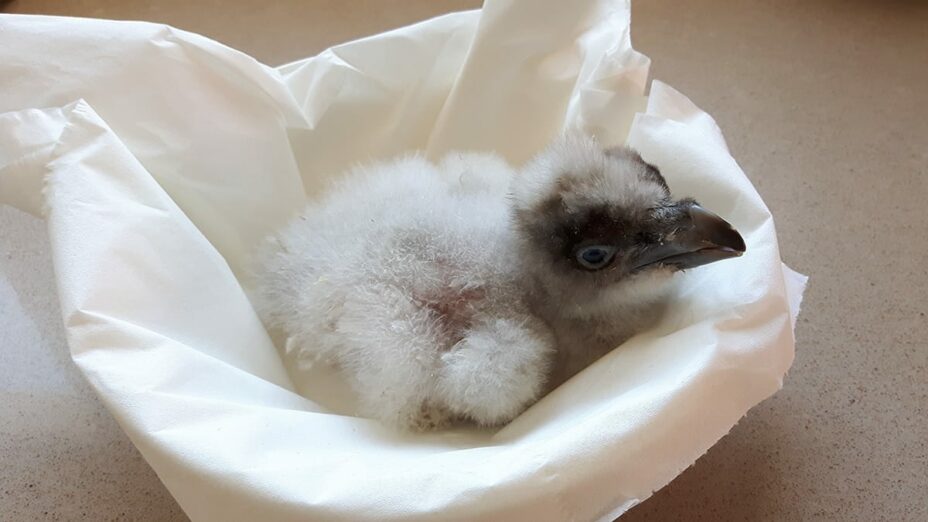Apollo, one of the 4 captive-bred Egyptian vultures released in August in Southern Italy, and the only one that was finally let free (one died and the other two had to be recaptured), has crossed the Mediterranean and arrived in Tunisia, on its migration south. He has already flown 1500km,
Before arriving in Sicily Apollo had already crossed the strait of Messina, and he was followed throughout by some dedicated volunteers coordinated by CERM, the Italian Egyptian vulture captive breeding centre that has coordinated the release.
On the 10th of September, for example, Apollo rooted for the night in a small stonewall near Mazara del Vallo, in Sicily, and was seen by Enzo Sciabica and Antonino Barbera. On the 12th september Apollo flew west to the island of Marettimo, following the long established route for migrating Egyptian vultures from Italy – his GPS stopped sending a signal for several hours when the bird was approaching Marettimo, which left us all anxious, fearing the worst, but fortunately yesterday it restarted to transmit, and revealed that Apollo spent two days in Marettimo, in a secluded are away from mobile phone network. On the same day Apollo flew southwest towards Tunisia, and we stopped receiving signs about 90 km from Sicily, when he was flying at 35 km/h. Fortunately the signals reappeard again from the island of Zembra, in front of the Tunisian coast, and a nature reserve – Apollo had successfully done the 170km cross of the Mediterranean, in about 5 hours!
The release of Apollo was part of trials to test procedures and get crucial data on the feasibility and relevance of captive-breeding and restocking/reintroduction projects with this endangered species. In August four young Egyptian vultures, all captive-bred in the Egyptian vulture captive breeding unit managed by CERM (Centro Rapaci Minacciati Onlus), were released in southern Italy, in the Appennino Lucano National Park (Basilicata),
In 2015 6 young had been released in southern Italy – 3 died while crossing from Sicily to North Africa, while two made it to Africa – you can see their whereabouts here, while last year 3 captive-bred Egyptian vultures were released in Bulgaria – two died in the sea crossing, but one made it to Africa.
This year the four birds released – one male (Apollo) and three females (Era, Teti and Atena), were already in their second year – all four had hatched in May and June 2016 in CERM and were kept in captivity until now. The idea was to try the “delayed release method” that has been used with some success in Israel. It was expected that the older birds would perform better on the migration and we had hoped that they would have a higher survival chance, but unfortunately this was not the case. The female Era was found dead under a tree – we are waiting for the results of the post-mortem, while females Teti and Atena had to be recaptured after showing signs of dehydration and weakness.
Apollo (and the other released birds) was equipped with a small GPS device which send us regularly their position and whereabouts – these tags were provided by the VCF, in the framework of our project to find out more about the movements of European vultures and hence also know more about mortality cases, a programme funded by MAVA Foundation.
The reintroduction or restocking of vultures to former distribution range has been a very successful conservation tool in Europe: the bearded vulture for example has been reintroduced successfully in the Alps and in Andalusia, and the griffon and black vultures have been also reintroduced in several places, including France (both species) and Bulgaria (griffon only).
While some of the reintroduction projects with griffon and black vultures can use wild birds originating in wildlife rehabilitation centres – after they are found weak or injured they are nursed back to health and then released in the projects elsewhere, with bearded and Egyptian vultures there is no possibility of using birds from the wild, so captive breeding is the only source of birds for reintroduction.
CERM has a lot of experience on releasing captive bred individuals, and since 2004 has released 19 young, all of them in the year they hatched.
The VCF developed successfully the methods for captive breeding in bearded vultures, and coordinates now the 40+ institutions that participate in the excellent captive breeding programme for reintroduction, and that produce on average 15-17 fledglings each year that are released in the four on-going reintroduction projects – Alps, Andalucia, Grands Causses and Corsica.
There are only about 10 pairs of Egyptian vultures left in Italy, in Sicilia, Calabria and Basilicata. This year a new LIFE project on the species will start in Basilicata and Puglia.
The following organizations were involved in this year´s release
Federparchi Federazione Italiana Parchi e Riserve Naturali
Ente Parco Nazionale dell’Appennino Lucano Val d’Agri Lagonegrese
Regione Basilicata
ISPRA Istituto Superiore per la Protezione e la Ricerca Ambientale
e-distribuzione spa
Centro Studi Appennino Lucano Onlus
Centro Studi Naturalistici Nyctalus Onlus
Ardea Associazione per la ricerca, la divulgazione e l’educazione ambientale Onlus
VCF
Sponsor: Co.Ge.Di. International, MAVA Foundation
Fotos: CERM



